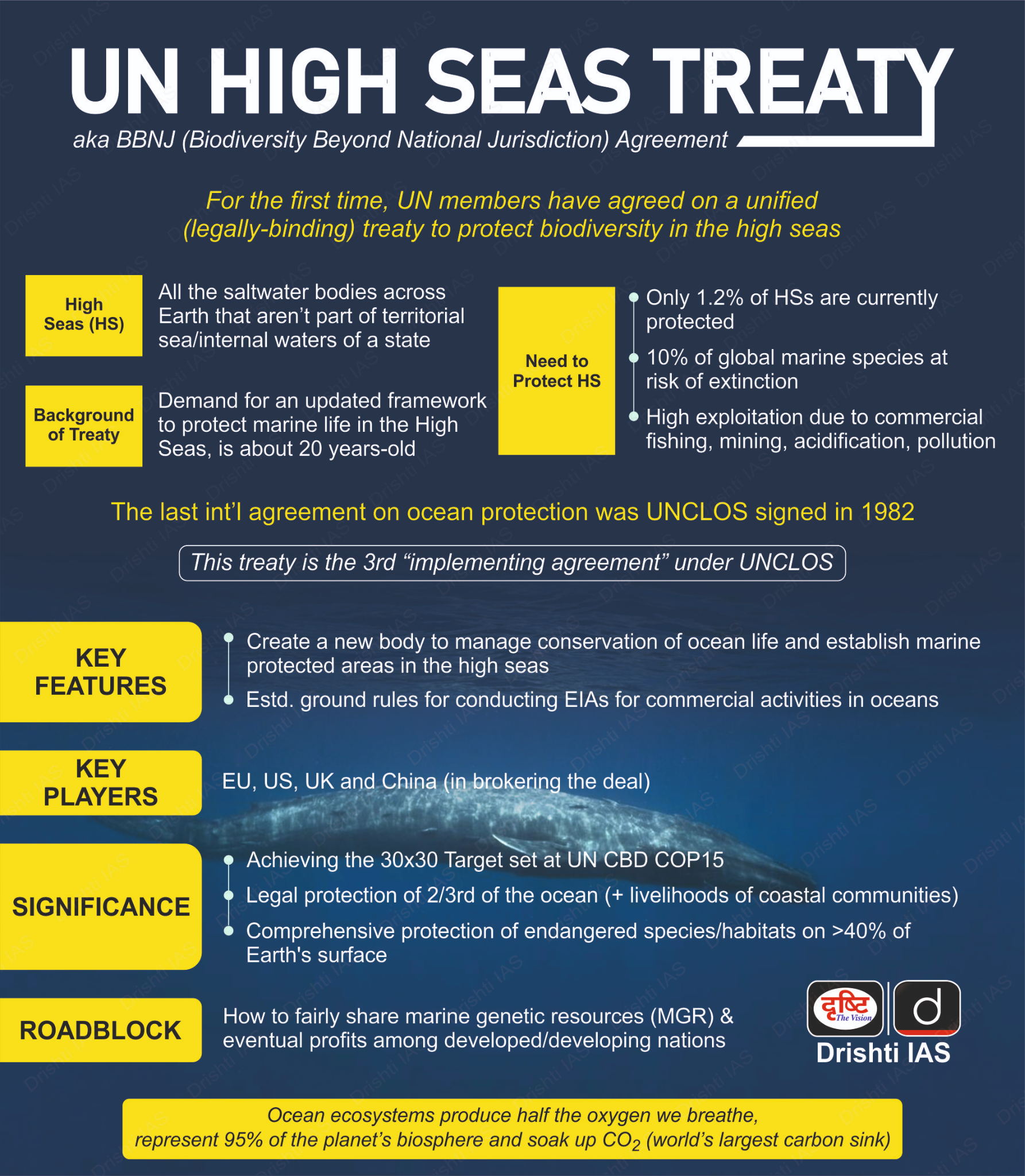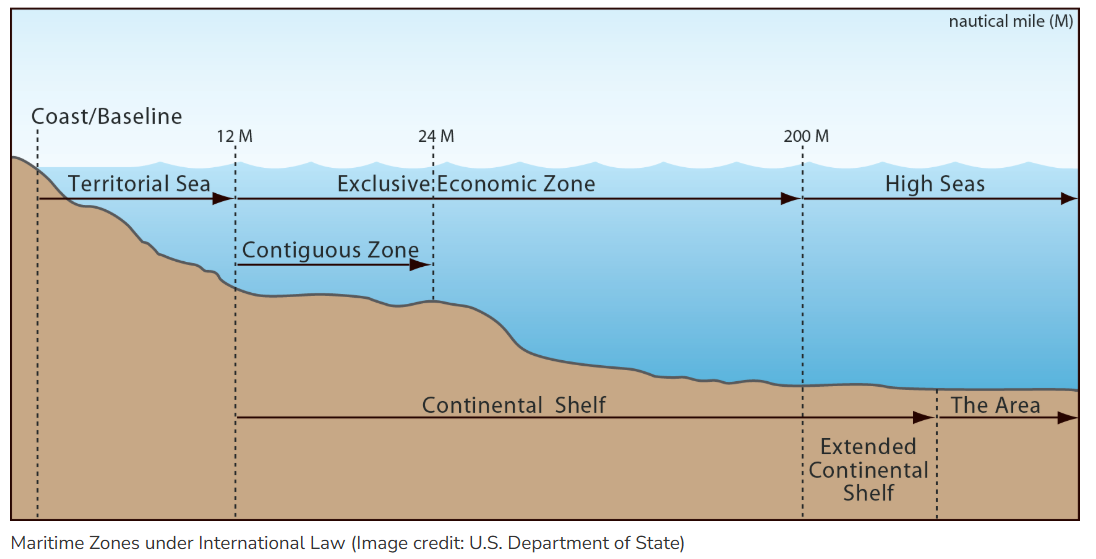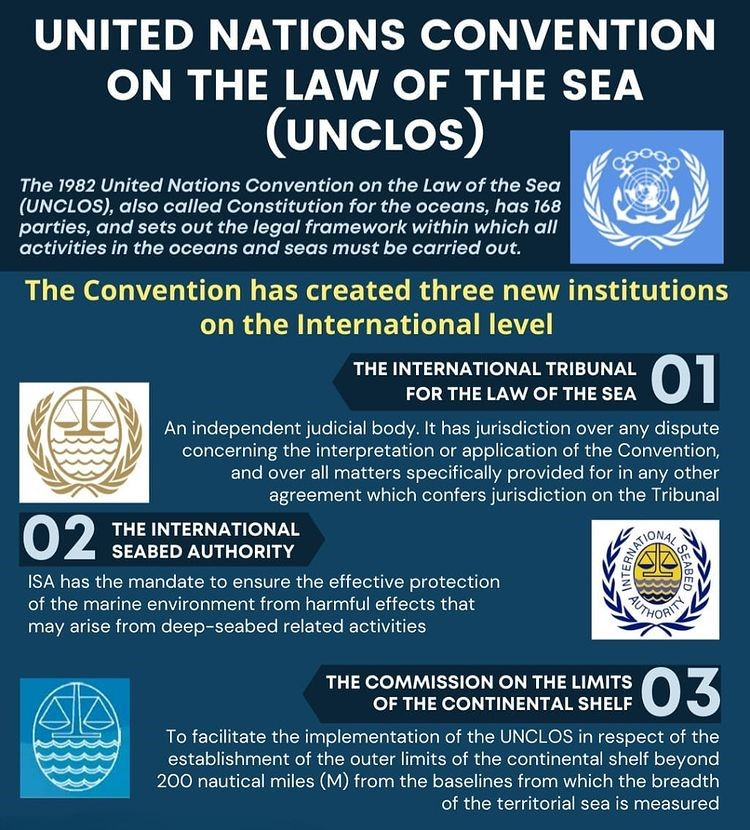India and the High Seas Treaty | 28 Nov 2024
For Prelims: High Seas Treaty, United Nations Convention on the Law of the Sea, Exclusive Economic Zones, Sustainable Development Goals, Ocean acidification, Blue economy, Mission LiFE, Convention on Biological Diversity
For Mains: Treaty on the High Seas, Significance for India, International Maritime Law and Ocean Governance, International Treaties in Environmental Protection
Why in News?
India signed the High Seas Treaty, formally known as the Biodiversity Beyond National Jurisdiction (BBNJ) Agreement, in September 2024, marking a major milestone in international ocean governance.
- However, implementation and geopolitical challenges raise concerns about its effectiveness.
What is the High Seas Treaty?
- About: The BBNJ Agreement developed under the framework of United Nations Convention on the Law of the Sea (UNCLOS) focuses on conserving and sustainably using marine biological diversity in areas beyond national jurisdiction, which are beyond the 200 nautical miles (370 km) of Exclusive Economic Zones (EEZs)
- The BBNJ Agreement once it enters into force becomes the third implementing agreement under the UNCLOS, complementing:
- The 1994 Part XI Implementation Agreement (focused on mineral resource exploration in the international seabed).
- The 1995 UN Fish Stocks Agreement (focused on conserving and managing straddling and migratory fish stocks).
- The agreement contributes to achieving Sustainable Development Goals (SDGs), particularly SDG 14 (Life Below Water).
- The BBNJ Agreement once it enters into force becomes the third implementing agreement under the UNCLOS, complementing:
- Need: High seas cover 64% of the ocean surface and 43% of the Earth’s area. They are home to about 2.2 million marine species and up to a trillion microorganisms.
- These areas belong to no nation, allowing equal rights for navigation, economic activities, and scientific research.
- In 2021, an estimated 17 million tonnes of plastic were dumped into oceans, with this number expected to rise. Lack of accountability leads to overexploitation, biodiversity loss, pollution, and ocean acidification.
- The treaty is vital for ensuring sustainable resource use, protecting biodiversity, and holding polluters accountable.
- Objectives of the Treaty:
- Marine-Protected Areas (MPAs): Focuses on establishing and regulating areas where ocean systems, including biodiversity, are under stress due to human activities or climate change, akin to national parks or wildlife reserves on land.
- These areas aim to conserve marine biodiversity and ecosystems.
- Marine Genetic Resources: Ensuring equitable sharing of benefits arising from the use of marine genetic resources, including drug development, and promoting open access to knowledge generated from these resources.
- Environmental Impact Assessments (EIA): Mandating prior EIAs for activities potentially harmful to marine ecosystems, including those within national jurisdictions that may affect the high seas, with public disclosure of the assessments.
- Capacity Building and Technology Transfer: Focuses on supporting small island states and landlocked nations in conservation efforts and enabling them to benefit from sustainable marine resource use through capacity building and technology transfer.
- Marine-Protected Areas (MPAs): Focuses on establishing and regulating areas where ocean systems, including biodiversity, are under stress due to human activities or climate change, akin to national parks or wildlife reserves on land.
- Signing and Ratification: The treaty would become international law 120 days after at least 60 countries submit their formal ratification documents. According to the High Seas Alliance, as of November 2024, 105 countries have signed the treaty, but only 15 of them have ratified and submitted it.
Note
Ratification is the process by which a country legally commits to an international law, distinct from signing,
- Signing indicates that a country agrees with the provisions of the international law concerned, and is willing to abide by it. Until ratified, a country is not legally bound to follow the law.
What is the Significance of the High Seas Treaty for India?
- Economic Benefits from Blue Economy: India’s blue economy contributes 4% of its GDP, with eco-tourism, fisheries, and aquaculture providing millions of jobs, especially in coastal areas like Kerala.
- Countries like those in Africa and India, with fleets mainly operating in their EEZs, are vulnerable to exploitation by foreign fleets in international waters.
- The treaty could help regulate fishing in these areas, ensuring sustainable use.
- The Pradhan Mantri Matsya Sampada Yojana (PMMSY), aims to boost the fisheries sector. Signing the High Seas Treaty will help protect fisheries and unlock new revenue in sustainable marine industries.
- Addressing Climate Change: The Treaty’s focus on marine ecosystems as carbon sinks is vital for combating climate change.
- For India, healthy marine ecosystems serve as buffers against coastal erosion, extreme weather, and rising sea levels.
- The treaty promotes nature-based solutions (NbS) like seascape restoration and MPAs, crucial for protecting coral reefs, which are at risk of collapse due to global warming.
- India's support for the treaty could play a key role in reversing coral reef decline.
- Alignment with SDGs and Global Commitments: Ratifying the High Seas Treaty would align India with SDGs 13(Climate Action) and 14, reinforce its Nationally Determined Contributions (NDCs) under the Paris Agreement, 2015 and support Mission LiFE (Lifestyle for Environment) and SAGAR Initiative.
- It would position India as a global leader in sustainable development and marine biodiversity protection.
What Challenges Does the High Seas Treaty Face?
- Lack of Ratification: The High Seas Treaty faces significant challenges, including slow ratification, with only 15 of 105 signatories approving it, due to geopolitical concerns.
- Disputes over maritime territories, such as in the South China Sea, hinder the creation of MPAs.
- Countries in Southeast Asia and those bordering the Bay of Bengal fear that MPAs may undermine sovereignty and national economic interests, complicating the balance between conservation and national priorities.
- Marine Genetic Resources: The treaty's provisions on sharing benefits from marine genetic resources raise accountability concerns, with the risk that wealthier nations may monopolize profits, marginalizing less-developed states and exacerbating existing inequities.
- Overlap with Existing Frameworks: The High Seas Treaty may conflict with the Convention on Biological Diversity (CBD) due to overlapping provisions on marine genetic resources, area-based management tools, and EIAs.
- The overlap with existing frameworks could fragment ocean governance, complicating enforcement and hindering smaller states' compliance with international norms.
- Lack of Clarity in Implementation: The Treaty sets broad objectives but lacks clear implementation guidelines, leading to inconsistent application.
- While EIAs are mandated, the treaty lacks specified procedures for conducting and enforcing EIAs, which could limit its effectiveness, especially in regions with limited capacity.
- It also neglects ongoing environmental damage from activities like oil and gas exploration and It fails to address the interconnectedness of marine ecosystems, particularly the impact of EEZ activities, such as overfishing and pollution, on high seas ecosystems.
- While EIAs are mandated, the treaty lacks specified procedures for conducting and enforcing EIAs, which could limit its effectiveness, especially in regions with limited capacity.
- Capacity-Building and Technology Transfers: The treaty lacks enforceable mechanisms for technology transfer, can potentially exclude low- and middle-income countries from its benefits and perpetuate inequalities.
- Additionally, many regions lack robust institutions to monitor and enforce treaty provisions. Conflicting domestic and international legal standards further dilute its effectiveness.
How Can the High Seas Treaty Address its Implementation Gaps?
- Integration of Coastal and High-Seas Governance: Develop a cohesive framework linking high-seas management with coastal regulations. Coastal states should align domestic laws with international norms for better synergy.
- Incentivizing Compliance: Offer technical and financial assistance to Global South nations for capacity-building.
- Wealthier nations must ensure equitable resource sharing and fund development efforts.
- Strengthening Enforcement Mechanisms: Establish robust monitoring and accountability frameworks. Enhance transparency through international oversight of EIAs and profit-sharing mechanisms.
- Building Political Consensus: Resolve geopolitical tensions, particularly in disputed regions like the South China Sea. Foster multilateral cooperation to ensure the treaty’s success.
United Nations Convention on the Law of the Sea
- UNCLOS, often referred to as the "Constitution of the Oceans," is an international law that defines the rights and duties of nations regarding the use of seas and oceans, covering sovereignty, passage rights, and economic usage.
- It demarcates marine areas into five main zones namely- Internal Waters, Territorial Sea, Contiguous Zone, Exclusive Economic Zone (EEZ) and the High Seas.
|
Drishti Mains Question: How does the High Seas Treaty align with India’s commitment to Sustainable Development Goals, and what impact could it have on India’s blue economy? |
UPSC Civil Services Examination Previous Year Question (PYQ)
Prelims
Q. With reference to the United Nations Convention on the Law of Sea, consider the following statements:
- A coastal state has the right to establish the breadth of its territorial sea up to a limit not exceeding 12 nautical miles, measured from baseline determined in accordance with the convention.
- Ships of all states, whether coastal or land-locked, enjoy the right of innocent passage through the territorial sea.
- The Exclusive Economic Zone shall not extend beyond 200 nautical miles from the baseline from which the breadth of the territorial sea is measured.
Which of the statements given above are correct?
(a) 1 and 2 only
(b) 2 and 3 only
(c) 1 and 3 only
(d) 1, 2 and 3
Ans: (d)
Exp:
- Under limits of the territorial sea every State has the right to establish the breadth of its territorial sea up to a limit not exceeding 12 nautical miles, measured from baselines determined in accordance with this Convention. Hence, statement 1 is correct.
- Under INNOCENT PASSAGE IN THE TERRITORIAL SEA, Subject to this Convention, ships of all States, whether coastal or land-locked, enjoy the right of innocent passage through the territorial sea. Hence, statement 2 is correct.
- The exclusive economic zone is an area beyond and adjacent to the territorial sea, subject to the specific legal regime established in this Part, under which the rights and jurisdiction of the coastal State and the rights and freedoms of other States are governed by the relevant provisions of this Convention. Under this the exclusive economic zone shall not extend beyond 200 nautical miles from the baselines from which the breadth of the territorial sea is measured. Hence, statement 3 is correct.
Mains
Q. With respect to the South China sea, maritime territorial disputes and rising tension affirm the need for safeguarding maritime security to ensure freedom of navigation and overflight throughout the region. In this context, discuss the bilateral issues between India and China. (2018)




